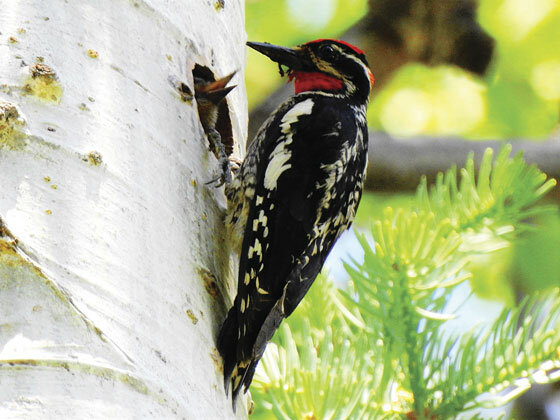
This week’s Bird of the Week, compliments of the Weminuche Audubon Society and Audubon Rockies, is the red-naped sapsucker.
One of the joys of visiting the woods during breeding season is being there for feeding time at a woodpecker nest. As young red-naped sapsuckers inside a cavity nest get older, their incessant calls for food get louder until, before long, mom or dad show up to drop food in the open beaks which appear at the hole. As the chicks age, feeding has been observed to occur every two minutes between dawn and dusk.
Red-naped sapsuckers excavate nest cavities in live or dead trees and exhibit a preference for quaking aspen infected with heartwood fungus. This disease softens the heartwood, which makes drilling easier, while leaving the outer trunk firm. As the disease progresses up the tree, sapsucker cavities get higher on the trunk.
These birds leave northern areas for the winter but often return to the same breeding site, tree and even cavity in succeeding years. Along with the Williamson’s and yellow-bellied (which shows up rarely), they are one of the three sapsucker species which can be found in our area.
Sap-lickers or sap-lappers might be a better name for these birds, which drill neat, small holes in the bark of trees to collect the sap flowing early in the xylem layer of conifers, and switching later to the phloem layer of deciduous trees where sugar made in the leaves is transported down to the roots. Small hairlike projections on the tips of their tongues act like the bristles on a paintbrush to soak up sap and trapped insects.
Sapsuckers spend much of their days attending to and defending their tree wells, keeping the sap flowing with anticoagulant chemicals deposited during drilling. Bats, porcupine and warblers may sneak in for some sap, and insects fed to sapsucker nestlings may be first dipped in sap. Red-naped sapsucker sap wells often act as a critical food source for migrating and wintering hummingbirds when flowers are not producing nectar.
Named for the patch of red feathers on the back of their necks, more prominent in males, these woodpeckers are colored black and white and have bright red crowns and red on the throat, also more prominent in males. For their roles in providing both food and nesting sites for other woodland species, they are one of the keystone species that allow our woodlands to remain biologically diverse.
For information on events, visit www.weminucheaudubon.org and www.facebook.com/weminucheaudubon/.